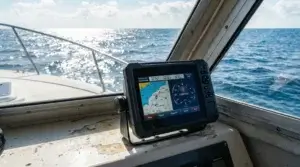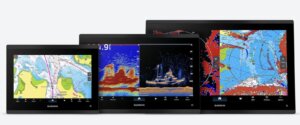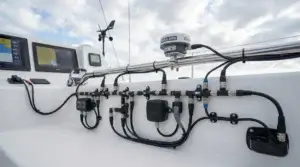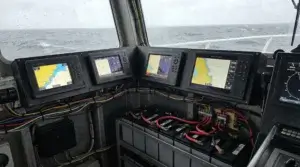I’ve been flying and filming with a drone for the fifth year, and I’ve amassed a little experience that I can share. I also do a bit of sailing, and I’d like to share some experiences about flying and filming with a drone from the sailboat.
Today, many of us are looking for answers with the help of artificial intelligence, such as ChatGPT or Google Bard and similar tools, but this does not always give a sufficiently correct answer. Below is one of the artificial intelligence-generated answers to the keyword phrase “How to fly a drone from a boat.”
Flying a drone from a boat can be challenging, but with the proper preparation and precautions, it can be done safely. Here are some steps to follow:
1. Choose the right drone: Select a drone that is suitable for maritime environments, with features like waterproofing, long battery life, and stability control.
2. Check local regulations: Before you fly a drone from a boat, you must check local regulations to ensure that you are not violating any laws.
3. Choose a safe location: Pick an open area on the boat where there are no obstructions like masts, rigging, or antennas. Ensure that there are no other boats nearby or in your flight path.
4. Prepare the drone: Ensure that the drone is fully charged, and the camera is set up for your requirements. Calibrate the compass and gyroscopes, and check the GPS signal.
5. Launch the drone: Carefully launch the drone from a flat, stable surface on the boat. Make sure that the drone is clear of any obstructions and that the blades have enough clearance.
6. Control the drone: Use the remote controller to fly the drone slowly and carefully. Keep a close eye on the drone and its surroundings to avoid collisions. Avoid flying too high or too far from the boat.
7. Land the drone: When you are done flying, carefully bring the drone back to the boat and land it on a flat, stable surface.
Remember to always prioritize safety when flying a drone, especially in a maritime environment. Check the weather forecast, avoid flying in high winds or heavy rain, and keep an eye on the battery life of the drone.
I would like to say that this is relatively far from reality.
My comments on artificial intelligence.
Point one is useless.
You’re flying a drone that you have, and they’re mostly DJI drones. DJI does not manufacture waterproof drones, except some raindrops can’t hurt one. I’m not commenting regarding battery life and stability control because that goes without saying.
There are also water-resistant drones on the market, such as Swellpro drones, which are a good solution for fishermen on calm water. However, it could be hard to hand-catch a 2.5 kg drone on a swinging sailboat, although this one might be worth exploring in more detail.
Second point.
Yes, ignorance or disregard for local regulations can lead to fines.
Number 3.
On a sailing yacht, it’s pretty hard to find a place where there are no riggings or any other obstacles, so by me, the best place is somewhere on the aft, though I once took off even from the downwind side of the bow, very risky and stupid action.
I don’t know how other boats nearby can interfere with a flight.
The fourth paragraph is valid.
Number 5-wrong.
Only hand launching, except with zero boat speed. I lost my previous DJI Mavic Air 2S when I tried to take off from the swimming platform, and the boat’s speed was about 2 knots. Even more, the app warned me that it was dangerous. I still don’t know why the drone took off a little and fell into the water.
Number 6.
There is always a lot of caution and attention to be paid when flying a drone, not just when flying from a boat.
Number 7.
This advice can only apply if you are on a large ship or motorboat that is still relative to the ground. As I mentioned, there is usually not enough safe space on the sailing yacht to land the drone on deck, so it has to be caught by hand. Best if you have an assistant who does it. If the boat is underway, it’s almost impossible for the pilot to catch it in this situation without hurting himself or damaging the drone. Such a maneuver is likely to end in drowning an expensive UAV.
I’ve seen a video where a drone gets caught with a big net. It may even be the safest way because you can only damage the propellers, which is a relatively cheap loss.
Either way, if you piloted a drone from a floating object, this procedure needs to be approached with maximum attention and preparedness; under no circumstances should you do so under the influence of alcohol or drugs.
What else could I add about the subject “How to Fly a Drone from the Boat.”
If flying from a moving boat, I wouldn’t use RTH (return to home). Not all drones have a Dynamic Return to Home feature. If not, then I recommend setting it to “hovering.” This is the case if a communication signal with a quadcopter is lost. This prevents the drone from flying back to where it took off from and unnecessarily drains the battery. It is wiser to take a boat closer to restore the communication signal.
I forgot to mention another tip for landing on a sailing yacht: Turn off all sensors! You can do this for some models in an app, like Mavic 2 Zoom or Pro. Today, I am flying and filming with DJI Mavic Air 2S, and the only way to do this is to switch to Sport mode to deactivate the sensors.
Once again, I warn that such a maneuver with sensors off requires caution from the pilot to avoid injuring people or damaging either the drone or yacht.
I’m not claiming a hundred percent truth and correctness anyway, but what I mentioned above is said from my personal experience.









Hi, as you said many of us are using AI these days. Sometimes when I’m asking questions from chat GPT it didn’t lead me to the right answer. I think one reason is that we have to ask our questions in detail and correctly. The question (how to fly a drone from a boat?) that you mentioned in your content with us can be a great example. Thanks for sharing this content with us.
I had tried flying a drone in land and I found the process pretty challenging so I can only imagine how difficult it can be to do the same from a boat that is moving or that is not stable. But everything depends on experience so I guess the more you try it the better you become. And obviously making sure to respect all regulations and environment.
Ai, just like Google cannot be trusted 100 percent of the time and it is always good to do due diligence when it comes to flying those drones, especially if surrounded by water. I for one am not a good drone flyer yet and have crashed the drone quite a few times, so I would not venture onto the water with my non-water-resistant drone.
I recently read an article about flying drones from boats and found it interesting. Thank you for providing some valuable insights on the topic, but I have some questions regarding the practicality of some of the tips. For example, you mentioned that hand launching is the only option when taking off from a moving boat. However, I have seen videos of drones being launched from a net, which seems like a safer option. Additionally, you advised turning off all sensors when landing on a sailing yacht, but I wonder if this is safe to do. Overall, I appreciate the article’s attempt to provide guidelines for flying drones from boats, but I think more research and real-world testing are needed to determine the best practises.
I’ve never flown a drone on the ground yet alone a boat, so amazing how you detail everything. For a beginner like me, which drone would you recommend starting out with? I have always been intrigued with them, just never had time to research the best one to purchase. Once I master that part on concrete, then I’d like to try it out from a boat seems like lots of fun.
Hi there,
I found your article on flying a drone from a boat to be quite informative, but I have a few comments and corrections based on my personal experiences. Point one regarding drone selection is somewhat off; most people will be using DJI drones, which are not waterproof, though some raindrops won’t hurt them. Swellpro drones are an option but challenging to handle on a moving sailboat. Your advice on local regulations is spot-on—ignoring them can lead to fines. However, finding a place without obstructions on a sailing yacht is nearly impossible, so the aft is usually the safest spot. Hand launching is crucial, as I learned the hard way when my DJI Mavic Air 2S fell into the water due to boat speed. When it comes to landing, hand-catching is necessary on sailing yachts, and having an assistant is ideal. Using a net could also be a safe method. Overall, your guidance is useful, but navigating through the points was a bit confusing. Flying a drone from a boat requires maximum attention and preparedness, never under the influence of alcohol or drugs.
Thanks for the comment! I agree that flying a drone while under the influence of alcohol is unacceptable. Losing a drone is just a matter of money, but you can injure yourself and other people. This post was written a while back, but since then, I’ve flown from the sailing yacht about ten times with no accidents. I only damaged the propeller once.
Hello Andrejs!
This is such a cool and useful guide! Flying a drone from a boat adds a whole new level of adventure, but I can see how it comes with unique challenges. Your tips on stability and GPS lock make so much sense—losing a drone over open water would be a nightmare!
Have you found any specific drones that handle boat launches better than others? I imagine some models might have better stabilization or return-to-home features for this type of environment. Thanks for sharing these insights—I’m definitely feeling inspired to give this a try on my next boating trip!
Angela M 🙂
Hi Angela!
Thanks so much for your kind words—I’m really glad you found the guide useful! You’re absolutely right; flying a drone from a boat adds a whole new level of adventure, but also a few extra challenges to keep in mind.
For boat launches, I’ve found that drones with strong GPS lock and obstacle avoidance make a huge difference. Models like the DJI Air 3 and Mavic 3 tend to handle movement well and have solid return-to-home (RTH) features, which is crucial when launching from a constantly moving platform. A good tip is to set the home point to “dynamic” (if supported) so the drone updates its return location as the boat moves.
Definitely give it a shot on your next boating trip—it’s an incredible experience! Let me know if you have any questions when you do.
Happy flying!
Andrejs ????????
Let me know if you’d like any tweaks! ????